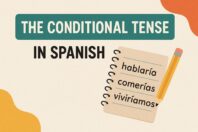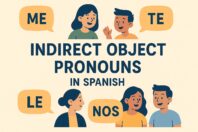Spanish Articles 101: How to say The and A in Spanish

Get our free email course, Shortcut to Conversational.
Have conversations faster, understand people when they speak fast, and other tested tips to learn faster.
More infoHow do you say the in Spanish? And what’s Spanish for a?
Spanish articles may not be quite as simple as in English, but the rules are pretty straightforward. Let’s just dig in and you’ll see what we mean!
Definite articles: “The” in Spanish
The Spanish the is actually quite similar to its English counterpart. This is called the definite article, because it identifies a particular thing, not just a thing. So what are the definite articles in Spanish?
In fact, we have four options for the in Spanish, depending on whether the noun is masculine, feminine, singular, or plural. Here are the four words for the in Spanish, corresponding to the noun’s gender and number:
| Spanish definite articles | Singular | Plural |
| Masculine | el | los |
| Feminine | la | las |
How can you know the gender of a Spanish noun? In fact, looking at the Spanish article is the easiest way to tell if a noun is masculine or feminine, which is why we always include a Spanish article before nouns in our vocab posts.
Another common clue is that masculine words often end in -o, while feminine words often end in -a. And like in English, Spanish plural nouns usually end in -s.
So now let’s see some examples of masculine and feminine nouns, in singular and plural, with their corresponding Spanish definite articles. For each one, they all translate into English as the:
- masculine singular: el carro – the car
- feminine singular: la mesa – the table
- masculine plural: los carros – the cars
- feminine plural: las mesas – the tables
A common beginner mistake is to forget to use the plural article when the noun is plural. It’s not “la mesas,” for example; it needs to be “las mesas.”
Before we have you give it a try, here are a few other examples of the Spanish the in both singular and plural. We’re not translating these words, but we hope you still understand what they each mean!
- el teléfono / los teléfonos
- el aeropuerto / los aeropuertos
- la rosa / las rosas
- la hamburguesa / las hamburguesas
Spanish definite article practice
Now it’s your turn. Even if you don’t know what the words mean, you should be ready to know which form of Spanish the to use. We’ve highlighted the words’ endings to make it easier. What are the definite articles in Spanish for each one: el, la, los, las?
- ___ castillo
- ___ hoja
- ___ radio
- ___ cartas
- ___ murciélago
- ___ hipopótamos
- ___ jirafas
- ___ esternocleidomastoideo
For more practice learning vocab, get free access to our Spanish flashcards.
Contractions with the prepositions A and De
When we simply mention the noun in Spanish, we use the definite articles as we’ve just seen above. However, if a masculine singular noun comes after the Spanish prepositions a or de, we need to form contractions with el to create al and del.
[the preposition a] + [the definite article el] = al
[the preposition de] + [the definite article el] = del
These contractions are obligatory whenever we have a el or de el. We don’t contract any of the other articles. See this with a few examples:
- Voy al banco. – I’m going to the bank.
- Voy a la farmacia. – I’m going to the pharmacy.
- Vengo del museo. – I’m coming from the museum.
- Vengo de la plaza. – I’m coming from the town square.
For a lot more detail on using al and del in Spanish, check out our full lesson on Spanish contractions. We also have a dedicated post with in-depth explanations of De in Spanish.
Lo in Spanish: The neutral definite article
In addition to the four Spanish definite articles we saw above (el, la, los, las), there’s one more special case that we should mention. Lo is considered the neutral definite article in Spanish, since it’s not associated with any gendered nouns.
So when do we use lo in Spanish? There are actually multiple grammatical uses for this little word, so we’ll point you to our full post where we explain five scenarios to use the Spanish Lo. In today’s post, we’ll just introduce when we use lo as a definite article.
The vital detail is that the definite article lo is not used on nouns. Instead, we use lo as an article before adjectives to talk about a thing that has that quality. In this case we always use lo followed by the masculine singular form of the Spanish adjective. This is best explained through some examples:
- lo bonito – the nice thing – the nice one
- lo mejor – the best part – the better one
- lo difícil – the difficult thing
- lo importante – the important thing
The exception: Some feminine nouns take El
For the most part, we can rely on the Spanish articles to follow the rules we saw above, where they always match the gender and number of the noun they describe. However, there’s one set of exceptions for singular feminine nouns that we should mention here.
When a feminine noun starts with a, á, or ha, we need to use the masculine article el rather than la. This is strictly for ease in pronunciation when the word’s first syllable is emphasized, to avoid repeating the back-to-back a sounds with la a-.
- el alma – the soul
- el arma – the weapon
In plural we still use the article las, since this no longer clashes in the pronunciation of las a-.
- el alma / las almas
- el arma / las armas
Even if we use el in these cases, the noun is still feminine, so any adjectives or pronouns will still need to respect its feminine gender.
- El agua está fría cuando la bebo. – The water is cold when I drink it.
To make it even more complicated, some feminine words that start with an a sound have their emphasis on later syllables, in which case we still use la as their article!
- la hamaca – the hammock
- la harina – the flour
We’re getting into fairly advanced grammar at this point, so don’t worry too much about these exceptions if you’re just starting out with learning the Spanish articles. If you’re keen though, check out our in-depth posts on Spanish accents and syllabification rules!
Indefinite articles: “A” and “An” in Spanish
Again, this compares directly with what you use in English: a or an. These are known in both languages as indefinite articles, since we use them to refer to a non-specific thing, as opposed to a particular one.
You’re being way less specific if you say a dog bit you, for example, as opposed to getting bitten by the dog.
In plural, you generally use some in English as the indefinite article, whereas in Spanish we just add an -s to our indefinite articles to make them plural. The same concept applies, though, for example getting chased by some dogs rather than by the dogs.
So what are the indefinite articles in Spanish? They follow the same principle as the definite articles, where they need to respect the gender and number of the nouns they describe. Here are the four options for a in Spanish, with the plural versions usually translating into English as some.
| Spanish indefinite articles | Singular | Plural |
| Masculine | un | unos |
| Feminine | una | unas |
Now let’s use the same nouns from above to demonstrate the indefinite articles Spanish uses:
- masculine singular: un carro – a car
- feminine singular: la mesa – a table
- masculine plural: unos carros – some cars
- feminine plural: unas mesas – some tables
Before we wrap up, let’s see a few more examples of the four Spanish indefinite articles in action: un, una, unos, unas.
Just remember that how to use articles in Spanish all hinges on the gender and number of the noun. This contrasts with English, where your singular indefinite article depends on whether the noun begins with a vowel or a consonant. Thus, un and una can both be a in Spanish or an in Spanish.
Likewise, in English you use some to describe unspecified plural nouns. So both unos and unas are equivalent to some in Spanish.
- un perro / unos perros – a dog / some dogs
- un aeropuerto / unos aeropuertos – an airport / some airports
- una casa / unas casas – a house / some houses
- una servilleta / unas servilletas – a towel / some towels
There is no neutral indefinite article in Spanish equivalent to lo that we saw above.
The exception we saw above with feminine nouns that take el as their singular definite article also applies to their singular indefinite articles.
- un alma / unas almas
- un arma / unas armas
Conclusion: Definite and indefinite articles in Spanish
We went through a fundamental grammar lesson in today’s post, learning how to say a and the in Spanish.
Known collectively as the Spanish articles, we saw how there are actually nine different words in Spanish, compared with just four in English. These can either be definite articles, corresponding with the English the, or indefinite articles, corresponding with the English a, an, and some.
In Spanish, articles need to match the gender and number of the nouns they describe, so there’s a masculine, feminine, singular, and plural version for each one. There’s also a neutral version of the definite article, lo, which can be used with adjectives.
To sum up, we’ll leave you with the two tables showing the eight Spanish definite and indefinite articles we use with nouns. Happy learning!
| Spanish definite articles | Singular | Plural |
| Masculine | el | los |
| Feminine | la | las |
| Spanish indefinite articles | Singular | Plural |
| Masculine | un | unos |
| Feminine | una | unas |



